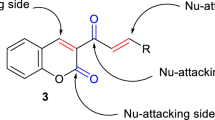Abstract
We are presenting results based on the density-functional theory, DFT, in order to obtain stable structures of the doxorubicin molecule that may lead for healthier ways to inhibit cancer cells for humans. We obtained several electrochemical properties; such as electronic affinity, chemical potential, chemical hardness, electrophilicity index, and ionization potential. The maximum reactivity zone of a molecule is obtained founding its HOMO–LUMO boundary molecular orbitals and reactive sites were determined by Fukui indices. The distribution of electric charges and Mulliken population were obtained to determine areas and sites with excess or deficit of electrons. The Raman spectrum was theoretically obtained. The information presented would be very useful for possible new anticancer drugs.
Graphical abstract




Similar content being viewed by others
Data availability
All data generated or analyzed during this study are included in this published article.
References
S.M. Swain, F.S. Whaley, Ewer MS. Cancer 97, 2869–2879 (2003)
C. Carvalho, R.X. Santos, S. Cardoso, S. Correia, P.J. Oliveira, M.S. Santos, P.I. Moreira, Curr. Med. Chem. (2009). https://doi.org/10.2174/092986709788803312
A. Pugazhendhi, T.N.J.I. Edison, B.K. Velmurugan, J.A. Jacob, I. Karuppusamy, Life Sci. (2018). https://doi.org/10.1016/j.lfs.2018.03.023
J. Yu, C. Wang, Q Kong, X. Wu, J.J. Lu, X. Chen, Phytomedicine (2018). https://doi.org/10.1016/j.phymed.2018.01.009
M. Slingerland, H.J. Guchelaar, H. Gelderblom, Liposomal. Drug Discov. Today 17, 160–166 (2012). https://doi.org/10.1016/j.drudis.2011.09.015
F.C. Maluf, D. Spriggs, Gynecol. Oncol. 85, 18–31 (2002). https://doi.org/10.1006/gyno.2001.6355
J. Wang, J. Zhang, M. Xiao, S. Wang, J. Wang, Y. Guo, Y. Tang, J. Gu, Cell Mol. Life Sci. 78, 3105–3125 (2021). https://doi.org/10.1007/s00018-020-03729-y
R.B. Weiss, Semin. Oncol. 19(6), 670–686 (1992)
M.L. Immordino, F. Dosio, L. Cattel, Int. J. Nanomed. 1, 297–315 (2006)
B. Petri, A. Bootz, A. Khalansky, T. Hekmatara, R. Müller, R. Uhl, J. Kreuter, S. Gelperina, J. Control Release 117, 51–58 (2007)
R. Von Moos, B.J. Thuerlimann, M. Aapro, D. Rayson, K. Harrold, J. Sehouli, F. Scotte, D. Lorusso, R. Dummer, M.E. Lacouture, Eur. J. Cancer 44, 781–790 (2008)
A. Sousa-Herves, S. Wedepohl, M. Calderón, Chem. Commun. 51, 5264–5267 (2015)
S. Vela, F.H. Huarte-Larrañaga, Carbon (2011). https://doi.org/10.1016/j.carbon.2011.06.067
E. Yaghoobpour, A. Ahmadpour, N. Farhadian, M. Shariaty-Niassar, Korean J. Chem. Eng. (2015). https://doi.org/10.1007/s11814-014-0250-9
R.G. Parr, W. Yang, Int. Quantum Chem. (1989). https://doi.org/10.1002/qua.560470107
J.P. Perdew, J.A. Chevary, S.H. Vosko, K.A. Jackson, M.R. Pederson, D.J. Singh, C. Fiolhais, Phys. Rev. B (1992). https://doi.org/10.1103/PhysRevB.46.6671
J.P. Perdew, K. Burke, M. Ernzerhof, Phys. Rev. Lett. (1997). https://doi.org/10.1103/PhysRevLett.78.1396
Qi. Li, Li. Fa-tang, Chem. Eng. J. (2021). https://doi.org/10.1016/j.cej.2021.129915
J. Sánchez-Márquez, V. García, D. Zorrilla, M. Fernández, J. Phys. Chem. A (2020). https://doi.org/10.1021/acs.jpca.0c01342
U. Sarkar, P.K. Chattaraj, Reactivity dynamics. J Phys Chem A (2021). https://doi.org/10.1021/acs.jpca.0c10788
R.S. Das, Y.K. Agrawal, Vib. Spectrosc. 57, 163–176 (2011)
Z. Farhane, F. Bonnier, A. Caseya, H.J. Byrnea, Analyst 140, 4212 (2015)
Acknowledgements
The authors are grateful for the support received from the National System of Researchers, (SNI) of the National Council of Science and Technology of Mexico (CONACyT), to Universidad Autónoma de la Ciudad de México (UACM), Instituto Politécnico Nacional (IPN) of Mexico, and to the Universidad Nacional Autónoma de México (UNAM). Also, one of the authors acknowledged for the UACM financial support, by the CCyT-2021-3 project.
Author information
Authors and Affiliations
Corresponding author
Ethics declarations
Conflict of interest
On behalf of all authors, the corresponding author states that there is no conflict of interest.
Supplementary Information
Below is the link to the electronic supplementary material.
Rights and permissions
About this article
Cite this article
Lopez-Chavez, E., Garcia-Quiroz, A., Santiago-Jiménez, J.C. et al. Quantum–mechanical characterization of the doxorubicin molecule to improve its anticancer functions. MRS Advances 6, 897–902 (2021). https://doi.org/10.1557/s43580-021-00182-2
Received:
Accepted:
Published:
Issue Date:
DOI: https://doi.org/10.1557/s43580-021-00182-2




